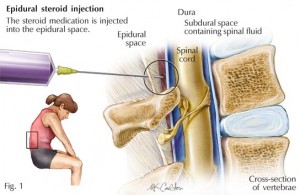(Image from Dr. Patricia Grant)
Epidural Steroid
Injections (ESIs): these are the most common injections performed in pain management. Usually, when your doctor plans to perform an “epidural”, they are referring to this injection. Epidural steroid injections are usually done via the “interlaminar” route, which is between the spinous process/lamina of two vertebral bodies (i.e. spine bone).
Common Indications for ESIs: There are many indications for ESIs. Some of the more common ones include neck and back pain. They also work very well for patient with radicular symptoms, such as neck pain radiating (i.e. “spreading”) to the arms and hands, or back pain spreading to the legs and feet. These injections can be done in the cervical spine for neck and arm/hand related pain, thoracic spine for mid back, rib pain, and chest/abdomen related pain, and the lumbar spine for low back and leg/foot related pain. ESIs are indicated for disc degeneration, spinal stenosis, herniated discs, radiculopathy/sciatica, spondylosis, vertebral fractures, shingles related pain, etc.
Technique: At SCCPM, most epidural steroid injections will be performed at the surgery center under live x-ray (fluoroscopy) for safety and accuracy. We will also give you moderate IV sedation (i.e. “twilight sleep”) as an option for your comfort, although many patients have had the procedure performed with local anesthetic alone without discomfort. You will be checked in at the surgery center and brought into the operating suite, where you will be greeted by the doctor and registered nurse. After placing monitors (e.g. blood pressure cuff, EKG, etc) on you, the nurse will give you IV sedation (if ordered). Afterwards, the doctor will begin by “numbing” the injection site with a local anesthetic. Afterward, with the aid of the fluoroscope, Dr. Lee will perform the actual ESI, in which a long acting steroid solution will be injected into your spine, where the inflammation causing your pain is located. After appropriate monitoring, you will then be transferred to the recovery unit before going home with a family member or friend. You are encouraged to “take it easy” for the rest of the day, and to follow the post-procedure instructions ordered by Dr. Lee. You will be able to resume your normal activities the next day.
Pain Relief Response and Duration: Most patients can expect pain relief to set in 1-2 days after the first injection. There will be some who will get immediate relief, while others may take 1-3 weeks for the relief to set in. There will be a small % of patients who may not respond to the injection at all. Unfortunately, the doctor cannot always predict your individual response beforehand. Likewise, the duration of pain relief is variable. Most patients can expect relief for months, and some have reported relief for even years. There will be a minority who responds short-term, with relief for only days to weeks, or not at all. Again, each patient’s response is different, just as each patient’s pain condition is unique.
Injection Series: Most patients get relief with just one injection, although a minority of patients will require more to get relief. There is no set rule on the number of injections required. In general, most pain doctors (including Dr. Lee) perform up to a “series of 3” ESIs. A “series of 3” injections may be performed to ensure pain relief as well as prolong the duration of pain relief (as mentioned above). There are no set guidelines to the number of ESIs a patient can get in a year or “life time”. But, in general, patients may need to repeat the ESI or ESI injection series when the pain returns over time. As each patient’s pain condition is unique, it is best to discuss with the doctor about your pain condition and the best course of treatment.

